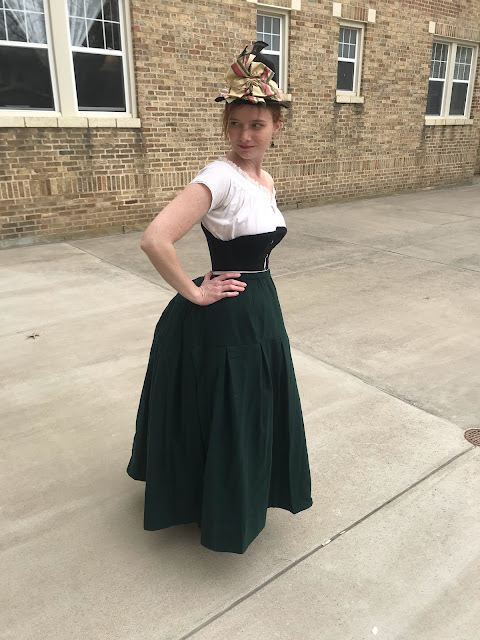Once the underskirt for my 1884 ice skating outfit was well on it's way to being completed - pattern fitted, skirt cut out, assembly begun - it was time to tackle the next part of the outfit. Arguably the most visible, most important, and most complicated, part of the ensemble - the bodice.
 |
| Photo credit: @papagena1791 |
The fashion plate I chose to base my ice skating bustle dress off of was from 1884 and featured a cut-away jacket front with a faux vest attached at the side seams underneath.
For my version of this bodice I decided to start with the "Ladies' Basque" pattern from the 1884 National Garment Cutter, available for free on Archive.org.
Using my apportioning rulers I drafted the pattern in my size and made a mock-up to try on over my 1880's undergarments - corset, bustle, and petticoats.
The mock-up was a bit too big in the chest above the bust and too long in the back, but those were easy enough issues to fix.
I pinned out the extra length in the back at the waist and the shoulders and trimmed away the extra width at the front.
Then I put the mock-up back on and the fun part began!
Using a Sharpie, I drew onto my mock-up the shapes I wanted the different layers of my bodice front to have.
I drew the shape of the "jacket" layer on one side and the shape of the "vest" layer on the other.
I then transferred all my fitting changes to my paper pattern and traced off new front pattern pieces from my adjusted pattern.
I then adjusted these traced off patterns to reflect the new bodice shape I'd drawn onto my mock-up for the jacket and the vest.
That done, I made a second mock-up from the new pattern and tried it on.
The new mock-up fit and looked just how I'd hoped it would! Look at how smooth the back lays!
I added sleeves and the collar to the mock-up.
And discovered a few more fitting alterations were necessary.
I changed the collar to be cut on the bias, rather than the straight grain, lengthened the sleeves, and re-shaped the armscyes. With all that done, it was time to cut this bodice out of the real fabric!
The bodice itself was cut out of two thrifted and disassembled Pendleton wool skirts - both the same color, one size 6 and the other size 16.
I disassembled my final mock-up to use as the bodice flat-lining.
It took some finagling, but I managed to get all the required bodice pieces cut out of the skirts with only a little bit of piecing required on the sleeves. The vest front pieces and the bottom third of the rest of the bodice were cut out of a green and brown wool tweed from my stash.
With all the pieces cut out I assembled the vest and the rest of the bodice separately, finishing all the edges, except the neckline, and leaving the shoulder seams open.
The edges are all finished with leftover bias tape and facings from previous projects.
The lapels, collar, and cuffs are all cut from a cotton velveteen I discovered in my stash which just happened to match the color of the wool I was using. Also in my stash, I found some green velvet ribbon of the same shade, so I decided to use some of that to trim the tweed part of the bodice with.
Once all the edges were finished, I sewed the vest fronts into the side seams of the jacket, sewed up the shoulder seams, set the sleeves, and attached the collar.
 |
| Photo credit: @papagena1791 |
It closely resembled the bodice from my inspiration fashion plate and fit wonderfully!
 |
| Photo credit: @papagena1791 |
The most complicated part of my ice skating outfit was done! Not bad for a week's worth of work!
 |
| Photo credit: @papagena1791 |
Two days before our ice skating outing and all I had left to do was make an overskirt and trim a hat! It should be smooth sailing from here!
 |
| Photo credit: @littlebitgerman |
The rest of the Ice Skating Bustle Dress Series:
~ Ice Skating in a Bustle Dress












































